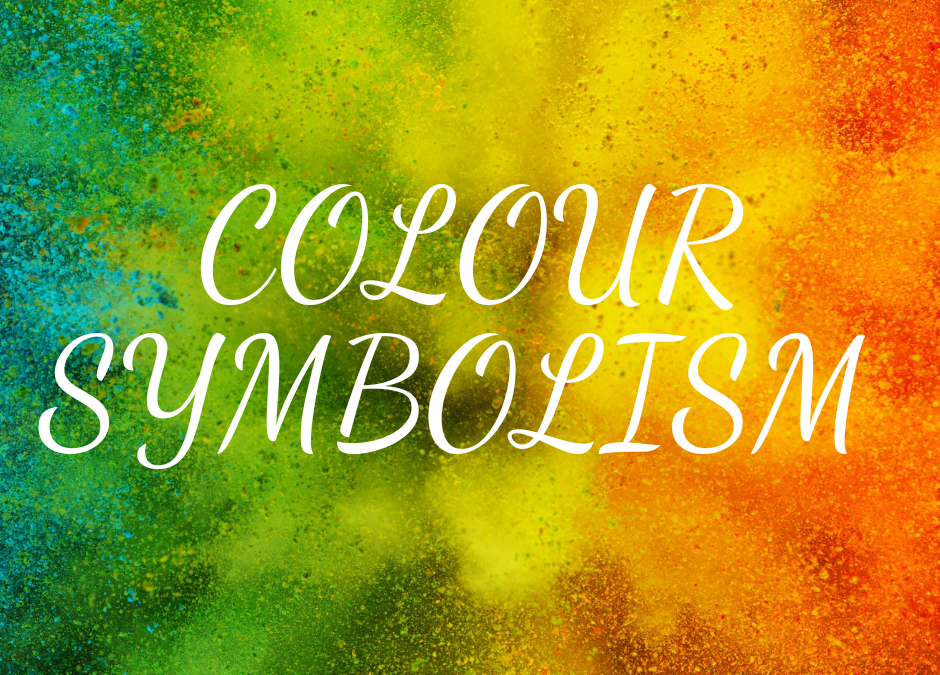Explore the symbolic meanings behind colours like red, green, blue, and more. Discover their cultural & historical significance.
COLOUR SYMBOLISM
- Red has been the usual Sunday colour in church, as well as the colour of penitence on Ash Wednesday, Good Friday, Easter, Whitsun, etc.
- White has become symbolic of Eastertide
- Yellow of confessional feasts
- Brown or grey, with violet, of penitence
- Violet or amethyst has been associated with passion and suffering in the church, as related to love and truth.
- The trinity of colour was red (divine love)
- Blue (truth and constancy),
- Yellow or gold (divine glory)
Through the ages, the use of colour has been characteristic of the nature of the people and the political, social, and economic conditions under which they lived. It has reflected their energy, power, wealth and cultural development.

RED – BLOOD
As used by the church in festivals of martyred saints and the Holy Cross, red signifies divine love, charity, martyrdom for the faith. The emblem of human life – Adam – means red. Red stands for health (India). It also represents a tragedy, anger (seeing red), shame (scarlet woman), courage, bravery, battle, strength, passion, love, guilt (red-handed). By association with blood and fire, red symbolises heat, war, hate, cruelty, power, destruction (Japan), danger, anarchy, revolution. Red is used by the Chinese in connection with marriage. In England, it is the colour of the Royal Family. Red stone was always used by the Native American for his Calumet. Pink is associated with beauty, tenderness and femininity.
ORANGE– AUTUMN
Orange symbolises rich harvests, plenty, abundance and completeness of life. Because it is the colour of flame, it also signifies light and heat.
YELLOW- FIRE & SUNLIGHT
Warmth, light, sun, marriage, fruitfulness (India), gaudiness, gaiety, lustre, enlivenment and glory (divine) are all included in the symbolic use of yellow. It is the royal colour of the Ch’ing dynasty of China, the colour sacred to Brahma, Confucius and Buddha. Further meanings are derived from the colour of gold – glory, power, wealth and greed; from the yellow robes of Athena, wisdom; from the treachery of Judas – portrayed by early artists as wearing a dull yellow robe – deceit, cowardice, inconstancy.
In France in the tenth Century, the doors of the houses of criminals were painted yellow. Saffron robes were used by confessors in the church. From the association with cowardice, we use the expressions: “He’s yellow”; “he shows a yellow streak”. To indicate indecency, we speak of “yellow journalism”. From the association with sickness and disease, we use a yellow flag for quarantine.
BROWN – ROCKS, TREES, EARTH
Solidity, strength, vigour, maturity and concentration (brown study) are symbolised by brown. It is, besides, a colour of penitence in the church.
GREEN – GRASS, FOLIAGE – SPRINGTIME
Youth, freshness, life, adolescence, growth, cheerfulness, hope, plenty, immortality (Egypt), faith, contemplation, memory, baptism (pale green), immaturity and inexperience (greenhorn). It is used by the church from Trinity to Advent Sunday. In early history in some instances, green was considered a sacred colour (Druids of England). A Mohammedan wears green on his turban when he has made the pilgrimage to Mecca. It is the colour of Ireland (shamrock), the colour of victory (palm branch), the colour of peace (olive branch), the colour of Neptune (green sea). It is also the royal colour of the Ming dynasty. Green is sometimes associated with jealousy (the green-eyed monster).

BLUE – SKY
Serenity (bluebird of happiness), loyalty (true blue), courage, fidelity, constancy, sincerity, piety, love of good works, hope, heaven, dignity, truth, generosity, divinity, peace, Christian prudence, sedateness, intelligence, aristocracy (blue blood), melancholy (feeling blue, blues singer). To the Cherokee colour of mourning.
PURPLE – VIOLET
In Indian, purple is the sign of tribulation. Probably because of its costliness, purple in early history was used only by royalty or the state. It was used by Roman Emperors (personification of Jupiter). It signifies secrets, the dignity of justice, mysteries, heroic virtue. Purple is the colour of penitence in the church in connection with the Saints, Advent, Lent, etc.
WHITE – SNOW
In the church, white has long been used in connection with festivals of angels, the Virgin Mary, Christ, the saints and also with matrimonial ceremonies. It symbolises purity, simplicity, the uncontaminated, the untouched, the unadulterated, innocence, truth, chastity, modesty, light, liveliness (without gaiety). The Chinese use it for mourning. Purity (lily), peace (dove), outward purity only (whitewash), surrender and humility (white flag), timidity (white feather), untried manhood (white shield), the delicate (white skin), the feminine, are all symbolised by white.
BLACK – ABSENCE OF LIGHT
Associated with darkness, fear, gloom, terror, dread, death, mourning, woe, wickedness, crime, evil, horror, as indicated in expressions such as: “black sheep” , “black tidings” , “black soul” , “black looks” , “black art” – a term applied to witchcraft, secret wisdom, diabolical power; “black flag” to piracy and lawlessness. In the church, black is a symbol associated with Good Friday, funerals and memorial services. In combination, black and white signify humility, melancholy, resolution, solemnity, prudence and secrecy.
GREY
Grey, having the attributes of black and white, at times denotes tribulation, penance, humility, age, mature judgement, sadness, quietude, dreariness, fear, solitude, death, sobriety and depression

